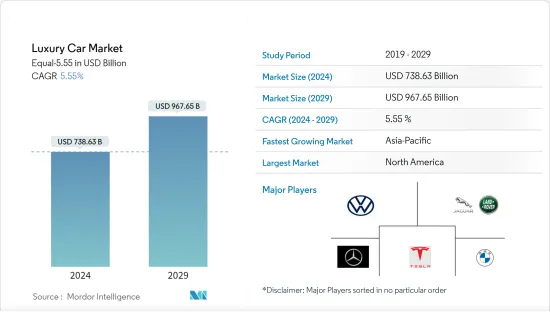PUBLISHER: Mordor Intelligence | PRODUCT CODE: 1523315

PUBLISHER: Mordor Intelligence | PRODUCT CODE: 1523315
Luxury Car - Market Share Analysis, Industry Trends & Statistics, Growth Forecasts (2024 - 2029)
The Luxury Car Market size in terms of Equal-5.55 is expected to grow from USD 738.63 billion in 2024 to USD 967.65 billion by 2029, at a CAGR of 5.55% during the forecast period (2024-2029).

The luxury car market has experienced robust growth in 2022, driven by key factors such as the expanding affluence of the global population, especially in emerging markets, where rising disposable incomes propel an increasing number of consumers to consider luxury cars. Furthermore, technological advancements, including innovations in electric and autonomous vehicles, are reshaping the landscape, attracting tech-savvy consumers seeking cutting-edge automotive experiences.
The luxury car market is experiencing a surge in electric and hybrid models, with major players investing heavily in research and development to meet the demand for eco-friendly alternatives. Connectivity features such as IoT capabilities, AI-driven interfaces, and autonomous driving technologies are becoming standard, elevating the driving experience.
However, economic uncertainties and stringent emission standards pose challenges for the luxury car market. Fluctuations in the global economy and environmental concerns can impact consumer confidence and influence purchasing power. In addition, an increase in import tariffs is expected to hinder the growth of the luxury car market. For instance, in India, cars with CIF (Cost, Insurance, and Freight) value over USD 40,000 incur a 100% customs tax, while those under USD 40,000 face a 60% import duty.
Based on these ongoing developments, the luxury car market is expected to continue its positive growth trajectory during the forecast period.
Luxury Car Market Trends
SUVs will be the Leading Segment in the Luxury Car Market
SUVs have emerged as the leading segment in the luxury car market. This growth could be attributed to several factors shaping the landscape of the luxury automotive industry. Luxury SUVs have gained significant traction, offering a combination of versatility, advanced technology, and a perceived sense of safety and prestige.
Luxury SUVs are becoming increasingly appealing to a broad range of consumers, including families and young professionals. The market has responded positively to the combination of performance, comfort, and practicality that these vehicles offer, making them a popular choice among luxury car buyers.
The elevated driving position and robust build of SUVs contribute to a sense of security, which resonates well with consumers seeking both safety and luxury in their vehicles. In addition, the incorporation of the latest technological features, such as advanced infotainment systems, driver assistance technologies, and connectivity options, has further enhanced the appeal of luxury SUVs.
Regional variances also play a key role in shaping the market for luxury SUVs. For instance, North America and China have shown a strong inclination for luxury SUVs. In China, the popularity of large SUVs among high-net-worth individuals has been particularly significant. While luxury sedans have historically held a significant market share in Europe, there is a growing shift toward luxury SUVs, reflecting changing consumer preferences and lifestyle choices.
Furthermore, factors such as economic conditions and environmental concerns also influence the dynamics of the luxury SUV market. Economic prosperity in certain regions has led to increased sales of larger and more expensive SUV models. Moreover, the rise of electric and hybrid SUVs addresses growing environmental consciousness among consumers, contributing to the overall evolution of the luxury car market.
As the automotive industry places greater emphasis on sustainability, automakers are investing heavily in electric vehicle technology, offering luxury SUVs with zero-emission capabilities. For instance:
North America is the Largest while APAC is the Fastest Growing Market
Luxury Car Industry Overview
Additional Benefits:
TABLE OF CONTENTS
1 INTRODUCTION
- 1.1 Study Assumptions
- 1.2 Scope of the Study
2 RESEARCH METHODOLOGY
3 EXECUTIVE SUMMARY
4 MARKET DYNAMICS
- 4.1 Market Drivers
- 4.1.1 Rising Demand for Comfortable Driving Experience and Vehicle Safety is Driving the Market
- 4.1.2 Increasing Number of High Net Worth Individuals (HNWI) and Ultra HNWIs Drives Demand
- 4.2 Market Restraints
5 MARKET SEGMENTATION (Market Size in Value - USD billion)
6 COMPETITIVE LANDSCAPE
7 MARKET OPPORTUNITIES AND FUTURE TRENDS
8 MARKET SIZE AND FORECAST IN TERMS OF VOLUME
9 PRODUCT BENCHMARKING OF KEY PLAYERS OPERATING IN THE MARKET




